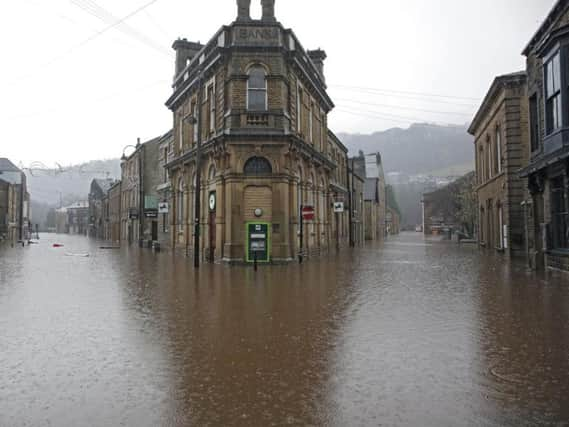The challenges protecting Hebden Bridge from floods but keeping its unique character


From computer modelling to experienced engineering and from man-made techniques to natural solutions, all aspects have been taken into account in ongoing planning for flood alleviation works in the town.
The Environment Agency’s Hebden Bridge project manager Simon Byrne presented progress on schemes, which should get under way in 2019, to members of Calderdale Flood Recovery and Resilience Programme Board at its December meeting.
Advertisement
Hide AdAdvertisement
Hide AdHebden Bridge is a steep and fast reacting water catchment, and a mixture of containment structures and upland water management using natural techniques to slow water flow down to the valley bottom will be used.
Looking at the whole picture means tributaries such as Hebden Water are being looked at as part of the solution as well as the main River Calder and parallel Rochdale Canal.
When completed works should give Hebden Water and one in 50 years rate of protection, said Mr Byrne, with a 1:100 defence for the River Calder and 1:50 protection from surface water.
Mr Byrne warned board members that although this protection was substantial a flood event of the severity of that which hit the Calder Valley on Boxing Day three years ago would not be preventable.
Advertisement
Hide AdAdvertisement
Hide Ad“It won’t protect from an event of December 2015 size when there was unpredictable rainfall in that area and everywhere was already saturated and soaked,” he said.
Upland measures would include further work with Yorkshire Water, whose upland reservoirs could play a part on holding back water, as well as work down in Hebden Bridge itself which would have to be effective while fitting into the town’s appeal.
Wall alignment and structure had to be assessed at the side of the rivers, gaps filled and barriers put in place.
With landmarks like the Packhorse Bridge and the Wavy Steps, both at Hebden Water, care would be taken that barriers were appropriate for what was already in place – work would be sympathetic to what was there, said Mr Byrne.
Advertisement
Hide AdAdvertisement
Hide Ad“Visual warnings for barriers coming up will be built in. It’s being refined in the design process.
“At the River Calder there are substantial walls there but there are gaps being rebuilt and assessments ongoing,” he said.
Regarding the Rochdale Canal, the appraisal identified the Adult Learning Centre site as being key for dealing with water overflowing from the canal into the River Calder.
In terms of surface water, the Co-op was a natural bowl and likely to be able to store some water.
Advertisement
Hide AdAdvertisement
Hide AdA detailed scheme for Stubbing Holme Road will form part of the Hebden Bridge Scheme.
Coun Jane Scullion (Lab, Luddenden Foot) asked questions about ensuring Hebden Bridge remained accessible, the role schemes on Erringden Moor might play and the Stubbing Holme Road project.
Anthony Rae, co-ordinator of Friends of the Earth, said three components – this plan, utilising the reservoirs and natural flood management – would make up the whole.
“If all three are put together the standard of the scheme will increase and the public will know all three elements are being used to maximise protection,” he said.
Advertisement
Hide AdAdvertisement
Hide AdRegarding the overall Calderdale Flood Action Plan progress, the board heard later in the meeting, two of four actions rated “red” which need progressing are likely to provide some solutions for the Hebden Bridge scheme.
These are assessing communities and properties where natural flood management could potentially reduce risk and increase resilience and developing a programme and securing funding to improve the resilience of the main highway routes in Calderdale, in particular the A646 in the upper Calder Valley.